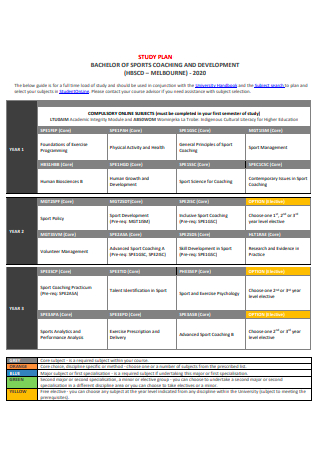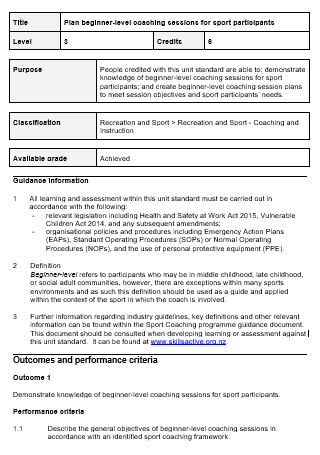8+ Sample Sports Coaching Plan
-

Sports Coaching Lesson Plan Template
download now -

Community Sports Coaching Plan
download now -

Sports Coaching and Development Study Plan
download now -

Sports Coaching Plan in PDF
download now -

Sports Coaching Plan Example
download now -

Sample Sports Coaching Plan
download now -

Sports Coaching Session Plan
download now -

Sports Coaching Framework Year Action Plan
download now -

Sports Participants Coaching Session Plan
download now
FREE Sports Coaching Plan s to Download
8+ Sample Sports Coaching Plan
a Sports Coaching Plan?
Benefits of Sports Planning
Instructions for Organizing a Sports Coaching Session
How to Build an Effective Coaching Plan
FAQs
What is a sports coach’s job description?
What is the coaching procedure?
Why should a coach design a strategy?
What Is a Sports Coaching Plan?
A sports coaching plan results from formulating strategies to achieve goals and objectives, address problems and facilitate the necessary steps. According to the Aspen Institute’s Project Play by the Sports & Fitness Industry Association, more than 6.5 million youth sports coaches are in the United States. Only about a third of these coaches for children aged 14 and younger have gotten training in sport-specific skills. Only around a quarter has received training in effective motivational strategies. This is especially concerning because a negative experience is a leading cause of children dropping out of sports. It isn’t easy to get youngsters back into athletics once they’ve left them. For the rest of their lives, they may be deprived of sports and physical activity benefits.
Benefits of Sports Planning
Writing training plans is an excellent method to earn money, recruit and retain athletes, and save time. You can come up with unlimited plan variations, or you can repurpose what you’ve already made for use in a plan. Now is a perfect moment to consider employing programs to help you build your organization. Here are five reasons why you should plan.
Instructions for Organizing a Sports Coaching Session
1. Determine Your Goals
Assess the demographics of the participants before diving in and starting your coaching session so you can set your goals. It will improve if you are prepared to avoid complications later. First, determine the participants’ age, amount of expertise in the sport you’re coaching, abilities and skills, unique health or cultural requirements, and the number of people attending the session. After you’ve gathered this information, you can go on to determine your goals. Ask yourself the following questions when you create your goals: What are the names of the participants? What kind of facilities and equipment are you looking for? How will we know if they have progressed or not? These questions will assist you in clarifying and condensing your goals.
2. Carry Out Your Responsibilities and Attend to the Needs of the Participants
After establishing your goals and objectives, it’s time to carry out the assigned tasks and responsibilities. It is expected that everyone will perform differently during training sessions. Some will improve significantly, while others will struggle. As a coach, you must be adaptable enough to assist your participants in the areas where they need to improve. You are there to mentor them while also encouraging them to persist. Additionally, you must ensure that sessions are enjoyable and safe, allowing participants to feel more at ease and less conscious while participating in the activities.
3. Create a Plan of Action in the Event of an Emergency
While creating a coaching plan is an excellent way to guide you as you conduct your sessions, things do not always go as planned. Numerous variables can affect your project, and you must be prepared to deal with unexpected events. Weather disruptions, illness, accidents, insufficient participants for sessions, facilities being booked, and so on can all affect your sessions. By developing a contingency plan or Plan B, you can address these issues without disrupting your sessions. Ascertain that your Plan B addresses all possible scenarios that may arise during your sessions.
Your sessions must include the following components:
Finally, don’t forget to give your participants feedback forms on their progress. The input will alert them to areas where they can improve or have made significant progress in their training.
How to Build an Effective Coaching Plan
The following are the primary steps for developing a coaching plan that enables learners to get the most out of their training.
Step 1: Identify the Plan’s Objectives
Determine what you want to accomplish with your coaching plan. You should identify weak points in your training. Are there any particular issues or skills that employees struggle to retain following activity? These are all areas where coaching can assist. Additionally, you may have objectives such as improved compliance training results for your industry.
Step 2: Provide Coaches with Training
Coaches must be intimately familiar with the training needs to assist learners. It is critical to select highly motivated coaches, who possess superior communication skills and are committed to staying current with training requirements. Coaches should receive ongoing training that emphasizes data analysis and paying close attention to learner feedback. This enables coaches to adapt their techniques to meet the needs of individual learners.
Step 3: Publicity for the New Plan
Coaching is ineffective unless people are aware of your coaching plan. To ensure that the coaching plan receives the maximum number of participants, spread the word in as many ways as possible. This includes the following: newsletters and emails from the business; at meetings, there is discussion; reminders posted on bulletin boards; and remind employees during in-person interactions. It is critical to present coaching as a benefit rather than an obligation when communicating information about it. Coaching enables employees to develop their skill sets, perform their jobs more effectively, and rapidly advance their careers. By emphasizing these benefits, you can encourage more employees to enroll in coaching.
Step: 4 Appointment of Coaching Sessions
After you’ve developed the plan and identified the appropriate coaches, it’s time to schedule sessions. These should be used in conjunction with routine training. Ideally, coaching should be tailored to the unique needs of each learner. Specific individuals will require more sessions than others. The key is to make coaching accessible to anyone who needs it and ensure that people feel comfortable seeking assistance. Scheduling is significantly more flexible when you use virtual coaching.
Step 5: Leadership Commitment
When organizations change or new initiatives are implemented, other aspects of the day-to-day organization must also change. These changes are most effectively implemented and sustained when senior leadership is on board. To ensure the success of a coaching plan, ensure that the plan is supported by effective coaches, business processes, and senior leadership assessment. Are employees available to participate in coaching sessions? Do coaches receive training to ensure their effectiveness? Do senior leaders value effective coaching and employee development? Is senior management supportive of the coaching plan?
Step 6: Examine the outcomes and make any necessary adjustments
It’s just as important to measure the results of coaching as it is to measure the success of your training plan and make any required adjustments. You can compare the results of employees who have received coaching to those who have not. It’s also a good idea to solicit subjective feedback questionnaires from people who have received coaching and solicit suggestions for improvements. You’ll be able to tweak and improve your coaching skills over time.
FAQs
What is a sports coach’s job description?
Every sports coach’s general responsibilities include teaching athletes relevant skills and tactics, monitoring and improving performance through encouragement and constructive feedback, identifying all strengths and weaknesses, providing health checklists and lifestyle advice, and developing training programs.
What is the coaching procedure?
Set precise measurable goals, agree on future steps in terms of actions and scheduling, and secure a commitment. Coaching is a two-way communication process that involves both the supervisor and the employee to be thoroughly engaged and motivated. Keep track of the employee’s performance.
Why should a coach design a strategy?
Planning doesn’t have to be a time-consuming procedure; with practice, the coach may rapidly analyze the session’s goals, identify exercises, and choose the necessary equipment. The efficacy and satisfaction of training sessions can be greatly enhanced by careful planning.
Coaching a group of individuals in a specific sport is not easy, but it is enjoyable, and the athletes’ increased performance is satisfying. Having a game plan can help alleviate the stress of planning a sporting event. Click on the templates and follow the instructions to learn more about establishing goals for specific events or groups. There are also printable and downloadable templates included, which you can alter to your preference.
